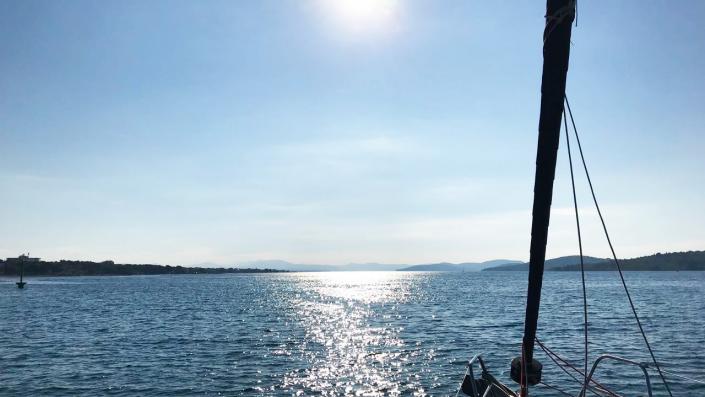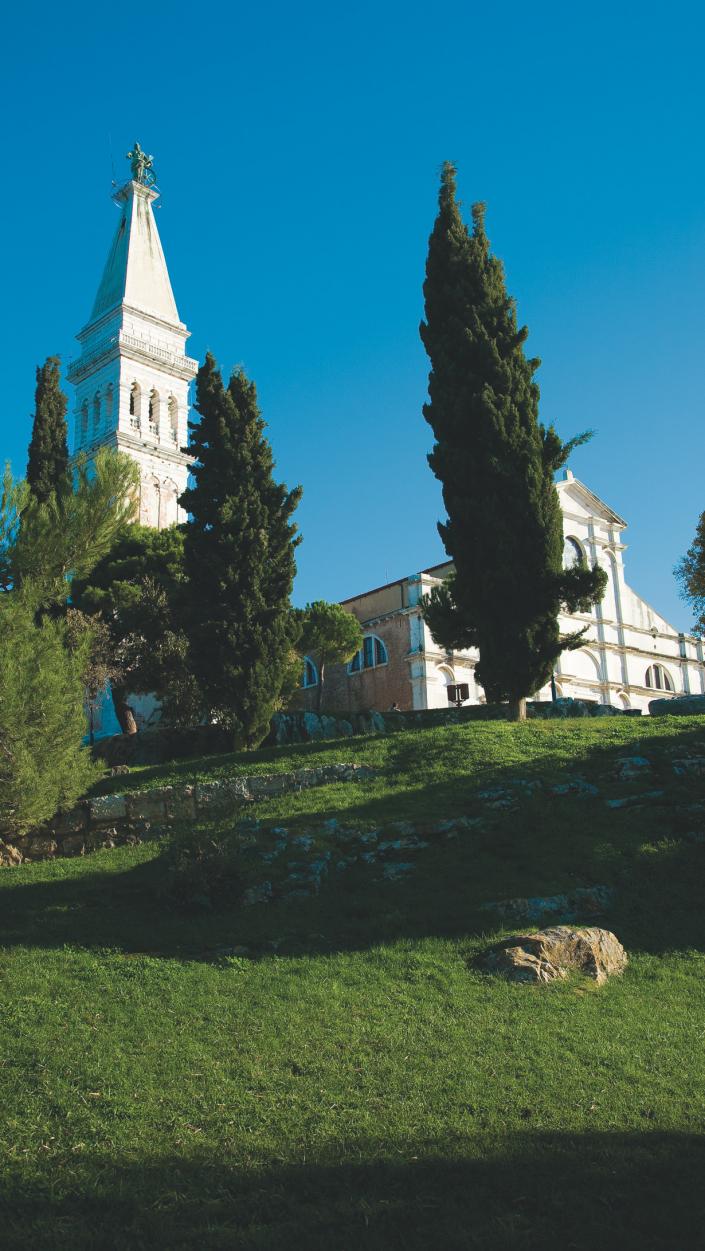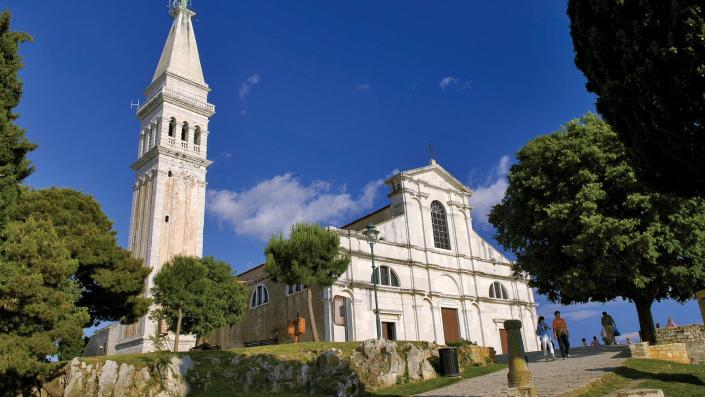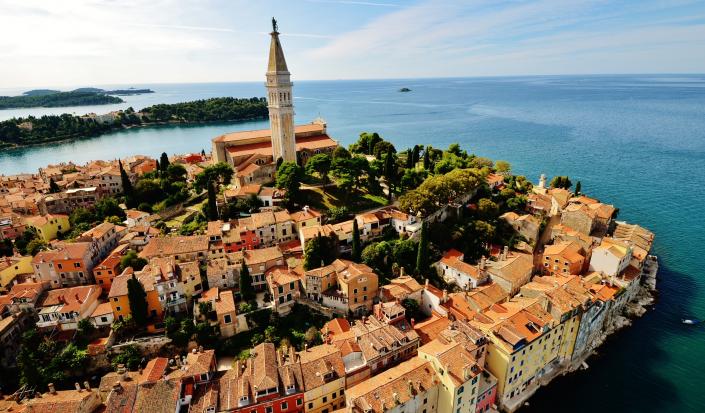Many of you know Croatia as a most sought-after tourist and sailing destination. But have you heard of a gem on the Istrian Peninsula called Rovinj? Well we were enamoured by this ancient and quaint town with its turquoise seas, picture-perfect colourful houses and shiny, well-worn cobblestone streets that surprised us at every turn.
Rovinj has an interesting and rich history dating way back to when it was a settlement of the Venetian or Illyrian tribes, through the Byzantine and then Frankish Empire in 788, and on and on through various rulers, the Roman Empire up to 1283 when it was governed by the Republic of Venice to 1797, then the Austrian Empire up to World War 1.
Until 1947 it fell under the Kingdom of Italy when it was ceded to SFR Yugoslavia and is now a part of Croatia since its independence in 1991. These changing eras are reflected in its treasured monuments and culture.
Both Italian and Croatian are the official languages of Rovinj, and Istriot, once a common Romance language in this area, is still spoken by some of its citizens. Rovinj was an island and joined the Istrian peninsula when the channel separating it from the mainland was filled in 1763. The Rovinj Archipelago with its 22 islets is an amazing playground for sailors to indulge in. The islands are rated as 'landscapes of outstanding value" for their preservation of a multitude of plant and tree species.

Sailing into Rovinj and exploring the old town
We had sailed into Rovinj in a chartered yacht, which we had berthed in the luxurious and ultra-modern ACI Marina. We would highly recommend this marina as it truly offers all the comforts a sailor's heart desires.
There is so much we wanted to see and do in this area, but today's plan was to head to the old town and up to the main focal point of interest that had attracted our attention, i.e. the Church of St. Euphemia.
After a leisurely early morning stroll along the promenade, soaking in the beauty of the seashore, the smells and sounds and picturesque sights of fishermen in their boats with squawking gulls circling around them and the hustle and bustle of the town's harbour, we got to Marshall Tito's square and walked through Balbi's Arch. Built in 1678/79 on the site of the old town's gate, the arch has the head of a Turk sculpted onto the one side, and the head of a Venetian on the other. This led us onto Grisia Street and we took our time checking out funky art galleries and interesting shops in the hub of the old town.
One of Rovinj's famous attractions that takes place every year on a Sunday in August is the Grisia open air art exhibition featuring the artwork of children, amateur and professional artists from all corners of Istria, Croatia and elsewhere. Grisia Street bursts into colour, people come from all over to revel in the creativity and prizes are dished out to the artists displaying the best works of art.

The legend of a young martyr - St. Euphemia
We then meandered uphill along the streets towards the church. Perched on top of the hill overlooking the old town of Rovinj, the Church of St. Euphemia bears testimony to an age-old legend of the patron-saint of the town. It goes like this:
In the year 290 a girl by the name of Euphemia was born in the ancient town of Calcedon on the other side of the Bosporus River from Byzantium (what we now know as the city of Istanbul). Her parents, Philophronos and Theodosia, were esteemed patricians i.e. the ruling class of families of that time in ancient Rome. Euphemia was consecrated to virginity from a young age.
During the Roman Emperor Diocletian's era from 284 to 305, many Christians were persecuted and killed. When Euphemia was 14 years old, Priscus, the governor of Chalcedon, had decreed that all citizens partake in rituals of sacrifice to the deity, Ares. Euphemia, together with 49 Christians, hid in a house where, in defiance of the decree, they were worshipping God. Diocletian's soldiers found them, captured them and commanded them to give up Christianity. When they refused, they were tortured for several days. The others were sent to the Emperor to undergo a trial, but Euphemia, as the youngest, stood her ground and asserted her devotion to Christ. She was then severely and harshly punished and was cruelly tortured on a wheel, but her spirit never broke. As a consequence, she was thrown to the lions. Although they killed her, they did not ravage her body so Christians gathered, retained and preserved her remains. Another version of the story is that the lions merely licked her wounds, but it was a wild bear in the arena that actually mauled the martyr to death.
Nothing was known of this young girl's earlier life, but her martyrdom was recorded in the hagiography (biography of a saint) titled "The Golden Legend" and her date of death as being the 16th September, 304.
In 620 the Persians took over the town of Chalcedon and the sarcophagus containing St. Euphemia's remains was transported to Constantinople. The Emperor Constantine built a grand church in her honour and there her bones were laid to rest. They lay in a golden sarcophagus until the Iconoclasts (icon-destroyers) took power and it was said that the sarcophagus was thrown into the sea.
The rest has been told and retold in tales of folklore through generations. Some say that in the year 800, two fishermen were caught in a big storm off the coast of Rovinj and got down on their knees to pray for their salvation. The next day (the 13th July) they woke up at dawn to see a white light shining above an object that was sinking into the sea. They were not able to retrieve the object, which turned out to be a marble sarcophagus, so rushed to tell the locals about this miracle and to find help. Many of the local residents tried, but failed to haul the heavy sarcophagus to the Church of St. George perched on top of the hill. As the legend goes, a small boy, who claimed St. Euphemia come to him in a dream, arrived with his two small cows and managed to drag the heavy sarcophagus to the church. Another version is that a pious widow used her oxen to retrieve it and pull it up the hill. Meanwhile a skeptic was struck unconscious and later expressed that St. Euphemia had come to him in a vision professing that the sarcophagus contained her bones.
Either way, this was hailed as a miracle and St. Euphemia was proclaimed the patron saint and protector of Rovinj. The hill was given the name of the Hill of St. Euphemia and to accommodate the influx of pilgrims arriving to pay her homage, a new and larger church dedicated to her was built in the mid-10th century. The relics, however, were not able to find their final resting place yet as were stolen by the Genoese, who then lost them to the Venetians, until they were finally returned to Rovinj in the 14th century.

The Church dedicated to St. Euphemia
The Church of St. Euphemia underwent reconstruction and remodelling, which was ultimately completed in 1736 and today stands proud in its Istrian Baroque style. We spent some time exploring it's interior, which is adorned with gothic statues, opulent artefacts and frescoes. Murals and paintings illustrate St. Euphemia's martyrdom and suffering, and, amongst others, there is the 16th century painting of "The Last Supper" and next to St. Euphemia's sarcophagus, a fabulous painting depicting the legend of its being pulled out of the sea. There is a statue of St. George with a dragon in its centre and three main marble altars bear statues of St. Mark and a lion, St. Roch with a dog and the magnificent main altar featuring a gold plated 15th centure statue of St. Euphemia surrounded by angels.
The more than 60 m tall Venetian-style bell tower is visible from afar and is capped by a weather vane shaped like St. Euphemia that twists and dances circles with the wind. Of course we couldn't have come this far not to go up to the top of the bell tower to get a better angle on the views below us. The entrance fee of 20 kuna (€ 2.6) is so worth it!
We looked down on the charismatic old town clustered below us with its terra-cotta roofs, harbour and beaches fringing the seashore. The 360 degree panorama view is amazing. Looking inland you can see the Istrian peninsula with its checkered fields of green growth and brown earth stretching inland. To the north we saw a beautiful bay lined with houses, shops and hotels along the seafront. Towards the east is the closest and second largest island of St. Catherine that dominates the bay with the smaller islands dotted in the cerulean blue sea stretching out beyond it. Beyond St. Catherine we could see the ACI Marina in all its splendour. We betted to see who could spot our yacht first and our skipper got it!! We planned to hoist our sail in a couple of days time and do a leisurely reconnoitre of the archipelago so from this lofty perspective it was fun to plot and point out the route we'd take sailing around the islands.
Every year on the 16th September, St. Euphemia's Day is celebrated on Rovinj's main square with a grand event attracting many visitors. On this day the tradition to eat mutton with sauerkraut and 'fritule' (a sweet Istrian fritter) is the order of the day.
There are many churches built in St. Euphemia's honour and she is praised throughout the Eastern Orthodox and Christian world. I bet you didn't know there is even an asteroid named after her - 630 Euphemia. It seems fitting that this esteemed saint even has a place amongst the stars.
---
Author: Diana Karmela
Photo: Robert Stanojević
Powered by:






